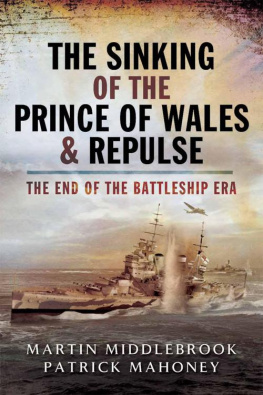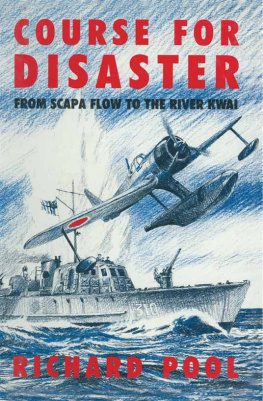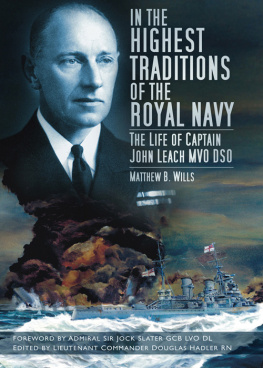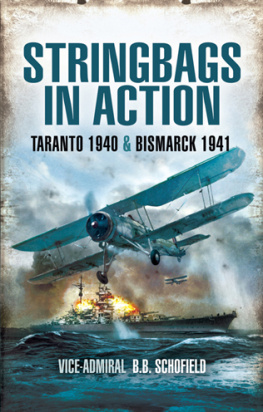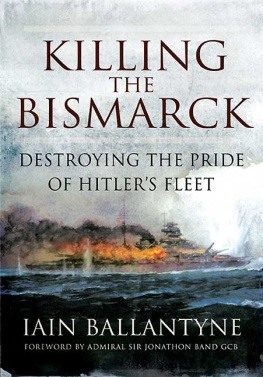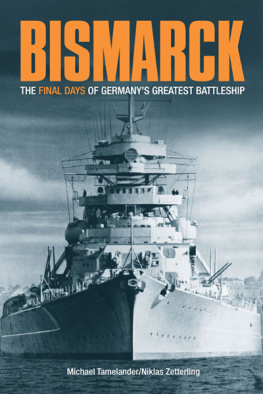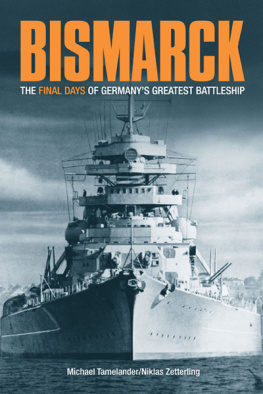THE SINKING
OF THE
PRINCE OF WALES
& REPULSE
Other books by Martin Middlebrook
The First Day on the Somme
The Nuremberg Raid
The Kaisers Battle
The Schweinfurt-Regensburg Mission
The Peenemnde Raid
The Falklands War
Convoy SC122 & HX229
The Berlin Raids
Firestorm Hamburg
The Argentine Fight for the Falklands
The Middlebrook Guide to the Somme Battlefields
(with Mary Middlebrook)
The Bruckshaw Diares (ed.)
Everlasting Arms (ed.)
Arnhem 1944
Your Country Needs You
Captain Stanilands Journey
The War Dead of Twyning Parish
The Bomber Command War Diaries
Denotes titles in print with Pen & Sword Books Ltd
THE SINKING
OF THE
PRINCE OF WALES
& REPULSE
THE END OF THE BATTLESHIP ERA
MARTIN MIDDLEBROOK
PATRICK MAHONEY
Pen & Sword
MARITIME
First published in Great Britain in 1977 by Allan Lane
Republished in 2004 by Leo Cooper
and reprinted in this format in 2014 by
PEN & SWORD MARITIME
An imprint of
Pen & Sword Books Ltd
47 Church Street
Barnsley, South Yorkshire
S70 2AS
Copyright Martin Middlebrook & Patrick Mahoney, 1977, 2004, 2014
ISBN 978 1 84415 075 5
The right of Martin Middlebrook & Patrick Mahoney to be identified
as Authors of this work has been asserted by them in accordance
with the Copyright, Designs and Patents Act 1988.
A CIP catalogue record for this book is
available from the British Library
All rights reserved. No part of this book may be reproduced or
transmitted in any form or by any means, electronic or mechanical
including photocopying, recording or by any information storage and
retrieval system, without permission from the Publisher in writing.
Printed and bound in England
By CPI Group (UK) Ltd, Croydon, CR0 4YY
Pen & Sword Books Ltd incorporates the Imprints of Aviation, Atlas,
Family History, Fiction, Maritime, Military, Discovery, Politics, History,
Archaeology, Select, Wharncliffe Local History, Wharncliffe True Crime,
Military Classics, Wharncliffe Transport, Leo Cooper, The Praetorian Press,
Remember When, Seaforth Publishing and Frontline Publishing
For a complete list of Pen & Sword titles please contact
PEN & SWORD BOOKS LIMITED
47 Church Street, Barnsley, South Yorkshire, S70 2AS, England
E-mail: enquiries@pen-and-sword.co.uk
Website: www.pen-and-sword.co.uk
CONTENTS
Maps
Text figures
At 11.00 on Wednesday, 10 December 1941, the crews of a formation of Japanese Navy Mitsubishi Type 96 aircraft sighted two large warships escorted by three destroyers steaming on an easterly course some fifty miles off the coast of Malaya. One merchant ship could also be seen near by, but there was no sign of any aircraft protecting the warships. The two larger ships were both British; they were the battleship H.M.S. Prince of Wales and the battle cruiser H.M.S. Repulse. Two of the escorting destryers were also Royal Navy ships, but the third was Australian. It was only the third day of the war that Japan had started in the Far East. The weather was fine and clear. Lieutenant Yoshimi Shirai, the pilot of the leading Mitsubishi, ordered his formation to attack.
That night there were great parties at two Japanese-held airfields near Saigon to celebrate a momentous victory against the hated British.
This is not the first book to be written about the loss of the Prince of Wales and the Repulse, but history is a subject that takes many years to unfold, both in the increasing availability of documents and in the continuing repercussions of events and the gradual realization of their implications. In particular, the publication in 1969 by the Japanese of their Official History and the release in 1972 of the British Second World War documents at the Public Record Office have thrown new light on this decisive action and justify a fresh study.
This book will aim to pass fairly quickly over those aspects of the subject which are common knowledge or are not controversial; it will concentrate more on those areas which earlier writers may not have been able to cover in depth. An attempt will also be made to tell the reader not just what happened on that sunny morning off Malaya, but what it was like for the men involved. One hundred and ninety-three officers and men who were serving in the warships attacked have been traced, together with others who were stationed at Singapore or other relevant places at the time of the disaster. We are fully aware of the pitfalls of relying on the human memory for descriptions of an episode full of confusion and emotional stress an episode furthermore that occurred more than thirty years ago. But the basic framework of the book has been formed from reliable contemporary records; the participants in the battle provide descriptions of smaller incidents never included in the official records and, perhaps more importantly, tell of their emotions at that dramatic time. The contributions of these men put flesh on the bare bones of the story and bring it more to life.
Our choice of title may need some explanation. We realize that the Repulse was a battle cruiser and that battleships and battle cruisers were designed for different roles in the event of a fleet action, but on 10 December 1941 neither the Repulse nor the Prince of Wales was operating in the strict role for which it had been built. Our title Battleship has been chosen for other reasons. Since 1918 the leaders of most of the worlds navies had been under pressure, sometimes in the bitterest of circumstances, to accept the argument that heavily gunned and armoured capital ships what may be called battleships, whether true battleships or dreadnoughts or battle cruisers had outrun their useful lifespan and that new weapons and their means of delivery the torpedo, the bomb, the submarine, the aircraft had rendered the battleship obsolescent. In Britain this argument had been put even before 1914. But in no country had the theory been fully accepted and vast quantities of money from national budgets had continued to be spent on battleships.
The clearest warning of all had been given by a famous American, Brigadier-General Billy Mitchell, Assistant Chief of the U.S. Army Air Corps between 1919 and 1925. After the First World War the U.S. Navy had wanted to re-equip with a fleet of new battleships. Mitchell argued, as forcefully as he could, that aircraft could sink by bomb or by torpedo any ship afloat. He proved it, though not to the U.S. Navys satisfaction, in trials during which his aircraft sank two empty ex-German warships a battleship and a cruiser in 1921, and then three old American battleships during the next two years. The experiments were naturally followed with great interest by other naval powers, but Mitchell and the other anti-battleship critics did not prevail. Billy Mitchell continued to agitate until exiled to a remote command for pressing his ideas too strongly, and then was court-martialled and suspended from duty for publishing his views in the press without permission. At least thirty-four battleships were launched and completed after this time at a cost of around 250300 million or $1,000 million, and many more of the older battleships were refitted and modernized at further massive cost. Most of the countries engaged in this battleship bonanza started their wars in 1939 or 1941 desperately short of aircraft carriers and anti-submarine vessels.
The action started by Lieutenant Shirai on 10 December 1941 proved conclusively that the battleship could no longer live with the bomb, the torpedo and the aircraft. The validity of this theory, so hated and resisted by traditionalist naval officers of so many countries, had taken a remarkably long time to find its proof,

